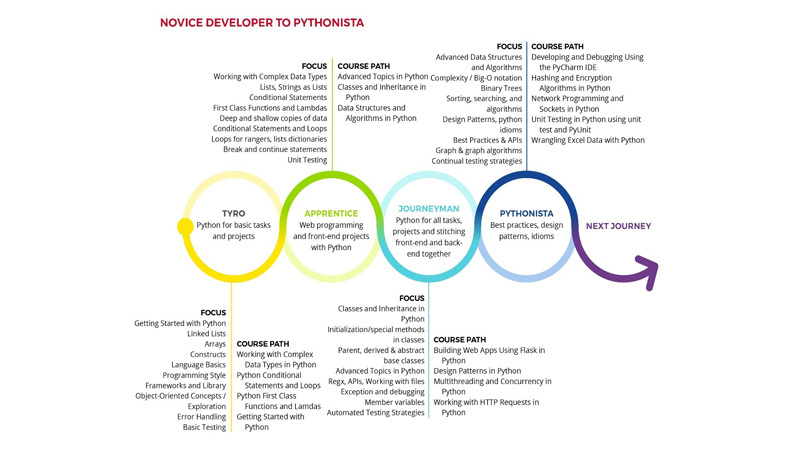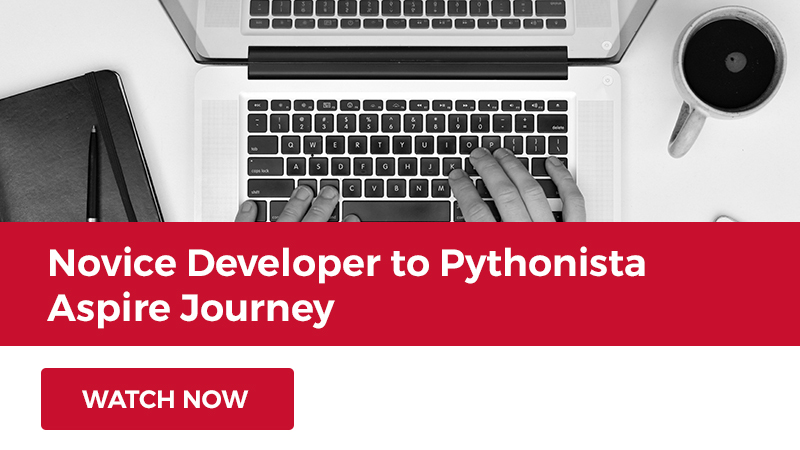What is a Skills Gap? (And Why It Matters)


Skillsoft designed and created the Python Novice to Pythonista Aspire Journey to help every enterprise leverage the enormous power of Python. The journey consists of four tracks - Python Novice, Python Apprentice, Python Journeyman, and Pythonista. What’s great about this is that each track represents a step-by-step progression making the transition from novice to expert easy regardless of prior level of experience.
Today, we want to go into more detail about what a learner can expect when they start their Aspire journey.
The Python Novice
This is the first and the most accessible of the steps. The primary appeal of Python is its simplicity and ease-of-use. Other programming languages can do all that Python can, but few - if any - technologies make complex tasks as intuitive and easy to structure as Python does. The Python Novice track focuses on the basic building blocks that make it all possible.
Absolutely no prior programming experience is required.
#1 Jupyter Notebooks and Anaconda
The first course in the track focuses on getting the learner up and running with Python. Today, Jupyter Notebooks based on Anaconda are the preferred mode of developing and running Python programs. This course will hand-hold the learner through the installation of Anaconda on different platforms, as well as the preliminary steps required to build meaningful programs. Jupyter’s interactive environment makes it especially easy for learners to explore the incredible power of Python’s libraries and built-in functions. We also cover essential topics such as the role of variables, and the semantics of simple data types like strings and numbers.
#2 Complex data
Python’s greatest appeal currently lies in its applications to data analysis and data science, and more complex data types are central to these applications. In the second course of the Python Novice track, learners will master the use of sophisticated data types such as lists, tuples, and dictionaries. Lists are perhaps the most intuitive and widely-used type in Python – iterable collections of data of any kind. The rules governing the use of lists are straightforward and intuitive and drive much of Python’s ease-of-use. Tuples are another vital data type. They are like lists, but immutable and are ideal for representing mathematical data such as points in space. Machine learning applications make very heavy use of the tuple abstraction, and this course covers all that a learner needs to know. Dictionaries - which represent collections of key-value pairs - are another favorite of developers, and these are included as well. The course also goes deep into the semantics of copying such data types, and the differences between shallow and deep copies.
#3 Control structures
The track then moves on to control structures - logical constructs such as for loops, while loops and conditional execution blocks. These play an extremely important role in constructing meaningful programs by allowing developers to alter the flow of program execution at will. The course covers the details of each of the significant control structures in Python, as well as the potential gotchas and pitfalls that could trip up novice programmers.
#4 Functions
The final element of this track is a detailed look at functions in Python. In a world of distributed, big-data applications, Python has a unique appeal because of the eclectic way functional and object-oriented programming paradigms are integrated. Functions can be stored in variables, passed into other functions as input arguments, returned from different functions, and even used as values in dictionaries. As a result, functions are genuinely first-class citizens in Python. This allows the construction of programs consisting of pure functions (functions without side effects), which in turn can be parallelized easily. Such programs are ideal for distributed execution - for instance, big data and machine learning frameworks can easily run the same function on different subsets of a large data structure on different processors.
After completing Python Novice, what is next?
The Python Novice track is the perfect first step in the Python Novice to Pythonista journey. It starts at the very beginning and makes no assumptions about the level of knowledge or experience of the learner. As a result, this track is great for those who are new to programming - business analysts, design professionals, product managers, as well as operations professionals. Whether you are an experienced programmer in Java, C#, or C++ who is looking to now extend your expertise to Python, an aspiring data scientist or data professional, or a business analyst or product manager seeking to communicate effectively with teams of developers, the Python Novice track will serve you well. The Python Novice track will also help enterprise leaders who manage large programming teams or projects and are eager to stay current with the latest technology. This is an ideal starting point for any enterprise looking to explore and harness the power of Python.


Yukti Kalra is a product manager at Loonycorn, a technical video content studio. She leads a team of content engineers and works on technologies that include machine learning frameworks and cloud computing platforms. Debranjan Puhan and Anuradha Usha are passionate about big data and python programming, and also work at Loonycorn as technical content engineers.
We will email when we make a new post in your interest area.

